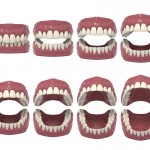
While oral health has improved markedly in recent decade there are still a significant number of patients who are edentulous and would require complete denture. In the USA the number requiring complete denture is expected to have increased from 53.8 million in 1990 to 60 million by 2020. While implant supported complete dentures are considered to be the most efficient and stable option they have increased cost compared to traditional complete dentures. In the mid 1990s computer-engineered complete dentures (CECDs) were introduced providing 3 advantages over traditional approaches, reduced numbers of appointments, improved fit/retention and electronic archiving.
The aim of this review was to assess the clinical complications associated with CECDs.
Methods
Searches were conducted in the Medline and Cochrane databases. Clinical studies involving a minimum of 5 patients reporting clinical complications or quality assessment of CECDs were included. Two reviewers independently selected studies and abstracted data summary data was presented
Results
- 5 studies involving a total of 82 patients were included.
- Overall unfavourable denture retention was 20.73% (17 of 82 participants
- Occlusal vertical dimension (OVD) ranged from 8.3 – 40 % in 3 studies.
- Centric relation (CR) errors ranged from 6.25- 14.28% in 4 studies.
- Overall patient’s dissatisfaction was 25.49%
Conclusions
The authors concluded: –
Based on the findings of this systematic review of CECDs, the following conclusions were drawn:
- Data were limited but revealed patient overall dissatisfaction, inadequate retention, and aesthetic discrepancies as the most common complications reported with CECDs.
- Lack of a trial placement option for CECDs could have resulted in complications related to aesthetics, OVD, and CR, leading to patient overall dissatisfaction.
- Difficulty in reading a digital preview was identified as a unique complication associated with CECDs.
Comments
As the authors note there were no clinical trials of CECDs before 2015 so this is an emerging technology. Consequently, only a small number of small studies could be included in this review. While the reviewers provide a good level of detail on the various quality assessments of the CECDs far less information is provided on the quality of the individual studies. Only one of the included studies compared conventional complete dentures with CECDs and it is not clear if this was a randomised study and no quality assessments of the included studies is presented.
A 2014 review by Paulino et al (Dental Elf – 23rd Oct 2014 ) suggested that simplified approaches to denture fabrication could be as effective as traditional approaches. So as this new review highlights the very limited evidence for CECDs , more and larger , high-quality studies comparing CECDs with simplified and traditional approaches are needed to better understand the clinical and cost effectiveness of these various techniques.
Links
Primary paper
Kattadiyil MT, AlHelal A, Goodacre BJ. Clinical complications and quality assessments with computer-engineered complete dentures: A systematic review. JProsthet Dent. 2017 Jun;117(6):721-728. doi: 10.1016/j.prosdent.2016.12.006. Epub 2017 Feb 20. Review. PubMed PMID: 28222878.
Other references
Dental Elf – 23rd Oct 2014
Compete dentures: no difference between simplified and traditional approaches to fabrication
